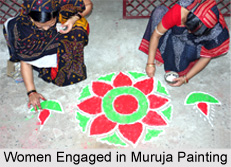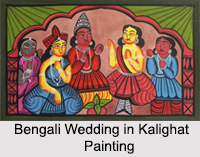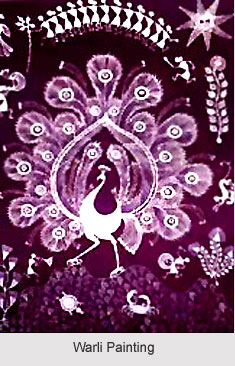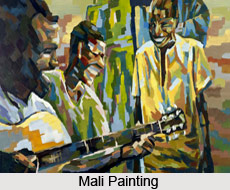 Mali paintings are those paintings done on caskets by the Hindu castes of Bihar whose chief occupation was making of garlands for worship. The paintings on the caskets were exemplified by brilliant and dazzling colors that are attractive and elegant. The subjects in the paintings were not portrayed in a literal or naturalistic manner and the wildest distortions were used by the painters to express an idea.
Mali paintings are those paintings done on caskets by the Hindu castes of Bihar whose chief occupation was making of garlands for worship. The paintings on the caskets were exemplified by brilliant and dazzling colors that are attractive and elegant. The subjects in the paintings were not portrayed in a literal or naturalistic manner and the wildest distortions were used by the painters to express an idea.
The Malis of Purnea district of Bihar were engaged in making of large paper caskets that are either four-sided and square or tapered to form a tall spire or pyramid. These caskets are made during the annual festival of Durga, which is celebrated in the towns, and villages of Purnea during September and October. They first construct a framework of bamboo strips and on this are pasted sheets of thin paper decorated with bold designs, which are painted in brilliant colors like magenta, bright yellow, vivid green and black. They sell caskets to worshippers for hanging them in shrines or temples to honor the Devi, who is known by different names as Bhagavati, Durga or Jagdami. The picture of Bhagavati is painted on one side of the casket and on the other sides are portrayed the pictures of a tiger, a horse elephant, and sometimes a pigeon, peacock or deer. The tiger is pictured, as it is the Durga`s mount. The horse and elephant symbolize royalty. The pigeons are usually offered by the devotees in her honor. The devotees hung the caskets as fulfillment of a vow or for curing illness. The second type of caskets they make are in association with the festival of the snake-goddess, Bishahari, which is celebrated in Purnea district during the monsoon rains of August. During this time snakes emerges from their holes and the villagers are at risk of snakebite. In order to avert this the snake goddess is invoked. The name Bishahar means remover of venom.
The caskets are made by men and colors are filled in by women and girls. The materials used were limited. Thin paper was employed through which the light of the lamp could shine. Brushes were made from the hair of goat`s tail tied on to bamboo sticks with jute fibre. The colors were made by the painters themselves. Red color was made from the flame of the forest flower. For yellow color powdered turmeric was used. Black color was made from lamp soot mixed with the lice of bean leaves. Green color was made from the juice of bean leaves. Objects, which constantly reappear in the paintings are reduced to a kind of shorthand. Round pink blobs or curved blobs represent lotus buds; sprays of loose petal shapes indicate lotus flowers; a curved blob with a hole in the center indicates an earthen lamp. The birds that frequently occur were usually described as pigeons but at times the crest; longish legs, the spreading tail and snake in the beak presuppose a peacock. Though Deer appears in the paintings artists had no idea of the reason for inserting it. In some cases the painters themselves were unaware of the exact identity of their stylized forms.
The village conditions in which these popular paintings were produced clarify the abrupt simplicity of style in which the paintings were executed. They had to be painted speedily since they were sold for very low prices. Even a large and towering casket with pictures were sold for one rupee; smaller ones were sold for four to eight annas. The painters did not leave their villages and there was no circulation of paintings. There was neither competition nor outside influence.
The paintings cannot be understood unless one knows the legend. The legend of the Bishahari plays a vital part in the paintings. Bishahari is the local Bihari name for the snake-goddess, Manasa. She has a wide number of devotees at Bengal. Her legend is described in the Bengali texts written between the fifteenth and eighteenth centuries. The legend says that, Manasa was an oblique offspring of Shiva and at the same time his triumphant rival. It is said that she was born from Shiva`s sperm which fell on to a lotus leaf and from there dropped to the head of Vasuki who was the king of water-snakes. Vasuki`s mother converted the sperm into a beautiful girl, Manasa. Vasuki entrusted Manasa with the snake and the poison. This became a problem for Shiva as Manasa`s snakes prevented him from enjoying his Lotus pond. So Shiva ordered Garuda, the traditional bird enemy of snakes, to devour them. Manasa employed her sexual wiles to defect Shiva`s anger. She persuaded him to take her in a basket to his home where his wife, Chandi mistook her for his mistress. Manasa for her part insisted that she was Shiva`s daughter and hence the stepdaughter of Chandi. There was a great quarrel and Chandi put out one of Manasa` s eyes with a red-hot coal but was herself struck dead by Manasa`s poison-dealing glance. At Shiva`s intervention Manasa used her antidotal powers and Chandi was rescued. As she proved to be his rival, Shiva slipped from her when she was asleep. While leaving her he sheds a tear and from it he creates another girl, Neto, a companion for Manasa. Shiva arranges her marriage with an old sage Jaratkuru and gives Neto as part of the marriage dowry. Neto is seduced by another sage and when Jaratkuru sees Manasa nursing Neto` s baby he is convinced of her infidelity and abandons her. This makes Manasa independent. The masses begin to worship her. There are a number of stories that proves her supernatural powers. When some cowherds insult her, she calls up her snake followers. She carries of her cows and returns them only when the cowherds agree worship her. She wages war with a Muslim landlord Hasan who at last worships her. She then disguises herself as an old Brahmin lady and asks two fishermen to help her to cross a river. When they do not help her, she prevents them from catching any more fish. At last they ask her forgiveness and carry her across. She then rewards them with a great catch of fish and amongst the catch are two gold pots, sacred to Manasa, from which shower of gold falls. Manasa at last succeeds in making Shiva`s devotee, Chando her worshipper. But he employs a sorcerer assistant to protect him against Manasa. He is also killed and his corpse is floated down a river on a raft and is presented to Manasa by her followers. She then turns him into a ram.
At the same time, Chando`s six sons are killed by eating rice mixed with snake poison. Their bodies also are put on a raft and are floated down to Manasa`s domain. Chando`s humiliation is completed by a voyage which he makes down the Ganges and Hooghly out towards Burma. Manasa, disguised as Shiva appeared to him in a dream and persuaded him to undertake this voyage. His is utterly destroyed in a great storm raised by Hanuman at Manasa`s instance and he lands on a shore but penniless.
The last episode describes Manasa`s final triumph. Despite all these vicissitudes Chando still rebels her. As a result of her intervention, a son, Lakhindar, is born to his wife, Sanaki, through insemination by a court dancer of Indra. Chando rejoices unaware of the deception. A girl, Behula, is similarly born to a rich merchant`s wife through insemination by one of Indra`s dancers. As time passes the marriage of Lakhindar and Behula is arranged, but Chando insists on a severe marriage test in which Manasa, disguised as an old woman, helps Behula as she was a devotee of Manasa. Lakhindar has been doomed to die on the wedding night. So Chando patrols the house and installs guards, but the snake of Manasa kills him. Sanaki curses Behula and she take her husband`s corpse on a raft and floats with it down to Manasa. Lakhindar is rescued and Behula promises that Chando will fully submit and worship her. Manasa restores Chando`s fleet and crews as well as his six sons and they return conceding defeat. Chando no longer worshiped Shiva and as a result Manasa`s victory is complete. The story undergoes many transformations in the Bihari version. As per this version, Shiva sheds five of his hairs, which falls and attach themselves to five lotuses from which five girls are born. These five girls jointly play the role of Manasa and are called Maina Bishahari, Devi Bishahari, Jara Bishahari, Dotala Bhavani (Bishahari) and Padma Kumari (Bishahari). In this version Shiva`s wife Chandi is referred to as Parvati. The five sisters send the snake that kills Lakhindar on his wedding night.
Unlike the Bengali versions where the emphasis was on Manasa`s exploits, the Purnea version stressed on the supreme role of Behula. The story of Behula`s marriage and journey down the Ganges with the corpse of her husband was given in detail in the Bengali version. It also describes her adventures at the eight ghats (landing places), while traveling with the corpse of her husband to revive him. The emphasis on Behula in Purnea district is reflected in a very special form when the worship of Bishahari takes place. During the festival the devotees assembled at a small shrine located between two village houses. Paper caskets which are known as manjusas were bought by the devotees. Each manjusa was painted from memory and intuition and each stroke was instinctive. Puja was done and mantras or charms against snakebite and songs extolling the Bishaharis were sung by the assembly. While chanting the mantras, the story of Behula was enacted in mime. During the course of the ceremony, an earthen lamp had been put in the caskets, together with a live pigeon and a little grain. A piece of cloth dyed with turmeric was wraped over the caskets and some money put beside them. In the final stages of the ceremony, rafts were made from pieces of bambooes. The caskets were tied on to them and carried in procession to the villagers home.
The Mails of Purnea when they made these caskets drew their imagery starting from the story of the birth of the Bishahari sisters in the lotus pond, the crossing of the river by Manasa, her rewarding of the fisherman with a great catch of fish, and the grisly journey of Behula on a raft with the corpse of her husband.
The prime subject is Maena Bishahari and her four sisters, who are jointly known as Bishahari. Maena Bisahari is portrayed as a woman holding lotus flowers, snakes or a fish. Sometimes she appears with her sisters who are painted as either women or as snakes and other times she herself is a great snake. In the caskets made during the annual festival of Durga she is portrayed as being accompanied by elephants and horses, which are the symbols of wealth, power and royal status.
The second main subject of the painting is a ferryman who is shown either standing in a boat with Maena Bishahari or catching a fish. This figure is identified by the artists as Goda Ghatwal. Ghatwal played a totally different role and far from catching fish was in fact murdered by his wives for making improper advances to Behula. In the main legend, the fisherman plays an important role since he ferries Manasa across the river and is one of the first to worship her. The Mali pictures clearly reflect this episode but only on account of Behula`s dominance. It is also possible that owing to the prevalence of Vaishnava beliefs involving Krishna in the neighbouring Bihar districts of Bhagalpur and Darbhanga, the popular story of Krishna`s exploit in ferrying Radha and the milkmaids across the river Jamuna may have given the role of the ferryman an added importance. In the paintings the roles of fisherman and ferryman appear to have been fused.
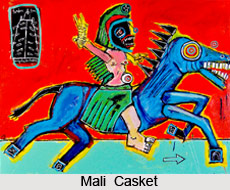 A third subject included on the caskets is Behula herself. She is shown seated with a small figure- her husband`s body - beside her. At times she is portrayed with a dolphin or an otter to indicate that she is in the sea. There are also other subsidiary images painted on the caskets. There are paintings of peacocks pecking snakes, pigeons, little clay lamps are painted in between as spots for it is used during the ceremony. Interstices between the figures are often filled with blowsy lotus flowers or lotus buds
symbolizing the birth of the Bishahari sisters. The paintings of snakes dominate all the caskets emphasizing Maena Bishahari`s role as goddess and controller of snakes. The snakes are painted as hurrying to accord Bishahari worship. In one painting we see her holding them in her hands, and in other the snakes are seen intertwined with each other. These pictures symbolize her ability to cause snake-bite but at the same time her power to cure it. In the paintings we find her being depicted as towering majesty and she is indeed the supreme godling of the area.
A third subject included on the caskets is Behula herself. She is shown seated with a small figure- her husband`s body - beside her. At times she is portrayed with a dolphin or an otter to indicate that she is in the sea. There are also other subsidiary images painted on the caskets. There are paintings of peacocks pecking snakes, pigeons, little clay lamps are painted in between as spots for it is used during the ceremony. Interstices between the figures are often filled with blowsy lotus flowers or lotus buds
symbolizing the birth of the Bishahari sisters. The paintings of snakes dominate all the caskets emphasizing Maena Bishahari`s role as goddess and controller of snakes. The snakes are painted as hurrying to accord Bishahari worship. In one painting we see her holding them in her hands, and in other the snakes are seen intertwined with each other. These pictures symbolize her ability to cause snake-bite but at the same time her power to cure it. In the paintings we find her being depicted as towering majesty and she is indeed the supreme godling of the area.

